Sean is a 50 year old engineer, originally from St Helens in Merseyside, but has lived for the last 22 years in Bradford in West Yorkshire. He classes himself as a general specialist angler, but his main summer species is barbel, with winters being devoted to pike, barbel and the occasional chub session. Perch, trout, tench and roach are targeted as the fancy takes him.
Sean has been a member of the Wharfedale Specimen Group for the last 16 years which has enabled him to learn from some of the finest barbel Anglers in the North of England.
Yorkshire Barbel – Part 1, Early Summer on the Shallows
THIS IS THE first of an occasional series in which I will write about aspects of my fishing for barbel in the Yorkshire rivers throughout this year. I’ll report on actual sessions, although I may join two or three sessions if I think it better illustrates a point. Just to set my fishing mate’s minds at rest I’ll not reveal swims or venues in an article; I’ll leave you to suss out those for yourselves, which is much more fun anyhow.
Tackle
Tackle for the Yorkshire rivers is fairly standard stuff. A twin tip rod with a quiver and an Avon top is handy, but the quiver top can be dispensed with in most circumstances. My rods are a Fox barbel Special 1.5lb test curve 12 footer, an 11ft Diawa Whisker Kevlar carp rod, a lovely soft rod that is slightly overrated at 2lb, so think of it as 1.5lb test curve, and a Korum Neoteric twin tip 1.75/2.2lb test curve 12 footer. The Fox rod has Avon and quivertip top sections.
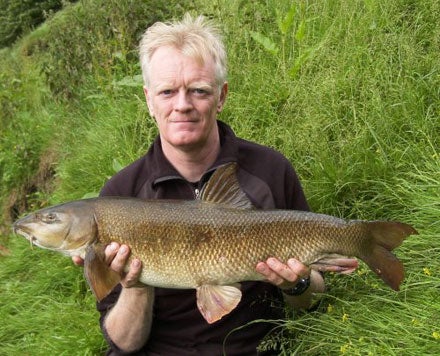  Sean and an 11.8 barbel he caught from the Swale this season (2006) |
Reels are 4000 size baitrunners loaded with 10lb and 12lb line, which is normally Berkley XT or Big Game. Centrepin reels are a viable option on these rivers and I use one for float fishing. Many of my mates use them for most of their barbel fishing as long casting isn’t generally required.
End tackle is very much a personal choice. The Wharfedale Specimen Group has some of the finest barbel anglers in the country as members; anglers of the calibre of Jon Wolfe, Mick Wood, Duncan Mellors and Mick Beecroft. None of us use the same terminal tackle and, allowing for time on the water and choice of venue, we all have similar success rates (except for Messrs. Beecroft and Wood who I think may have been fish in a previous life as they are both approaching a 100 barbel each already this season!). So it’s a matter of confidence I think.
My choice is a short braid hook link (Drennan sinking microbraid 10lb or 12lb) about 4 inches long with a size 14 Drennan barbel Specialist hook. The short braid hook link tends to present problems with its poor abrasion resistance, although I do check it carefully after catching a fish. I make up my own John Roberts feeder booms from his 3.2 mm stiff rig tube and his ledger beads; much cheaper than buying the made up ones. This is stopped with a Drennan leger stop. The tail length varies from about a foot to as much as 3 ft. More of this later.
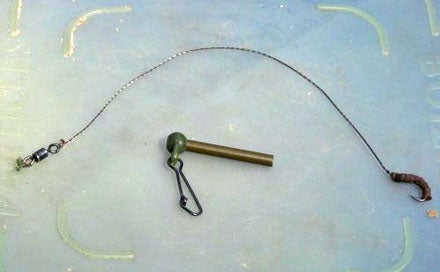  4″ Braid Hook Link and ‘Feeder Boom’ |
Bait
At one time I would have said that you needed to take nothing more than the ubiquitous pellet. Now I’m not so sure. Certainly in the more heavily fished stretches the barbel have seen a lot of pellet and some people have been feeding it like hemp seed. I’m firmly convinced that this is doing the fishing no good as it is overfeeding the fish. My strategy for this season is to fish pellet in small quantities, but also to use hemp, pigeon conditioner and casters more often as the season progresses.
I’m also firmly convinced that most people use too large a pellet and I tend to use 8mm halibut pellets banded on to a size 14 hook. This has the advantage of allowing you to change over to double caster without changing hook. My personal best before the 11lb 8oz fish was caught on a single tare on a size 16 hook from a heavily fished day ticket stretch. I used exactly the same tackle as I’ve described above. Don’t be afraid to use small baits, especially when using the feeder.
My friends have had good success with boilies but I use them very little. Good flavours to try are Trigga, The Source and Halibut Pellet.
Now lets go fishing!
First trip
After the first two weeks of the season barbel start to spread out through the river away from their spawning shallows. There are, however, still some very big fish to be caught on the shallows throughout the summer months and the high angle of the sun and bright conditions lend themselves to a stalking approach.
It’s a warm sunny day as I creep over the flood bank, perfect for spotting fish in the shallows. The swim I want to fish is one I found last season. Its an almost perfect early season swim, with cover for the fish and a handy nettle patch for me to fish from! The river is at normal summer level with a very slight tinge of colour from some rain a few days ago.
I creep carefully down to the nettle patch, the last few yards on my belly, and peer into the swim. Two smallish barbel and two decent chub are cruising through the swim, moving out into the fast water, drifting downstream and repeating the process. I’ve two pints of casters and a few halibut pellets for bait and I carefully throw a couple of handfuls of casters into the silt at the head of the swim. I leave the swim for half an hour and get my tackle ready a fair distance upstream.
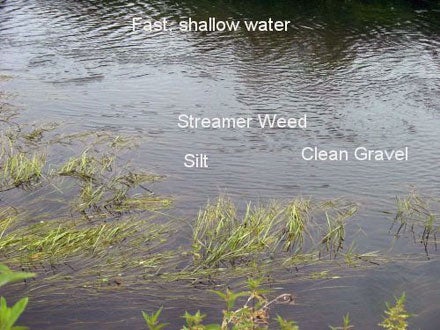  The Nettle Patch Swim |
When I return the barbel and chub are still circulating, but not stopping to feed on the casters. I try feeding some more and I can get the chub taking them in mid water, but they still won’t take baits off the bottom. I try introducing a handful of pellets and go for a walk, marking down a few likely swims for later and introducing a few pellets into each.
On my return to the nettle patch the silt at the head of the swim is now clouding the water and several tails are waving happily close to the surface. Success! I nip back down for my tackle, not making as much effort to conceal myself due to the silt clouds. I set myself up comfortably just above the nettle patch and peer carefully over the top to see an empty swim. Ah …… time for a rethink.
I crawl to the downstream end of the nettle patch where I can see what is going on, throw in a small quantity of pellets and settle back to watch. Before long the group of chub and barbel return and the barbel are soon grubbing about in the silt for pellets and casters. I then see the problem. The chub aren’t comfortable in the cloudy water and hang off to one side, making occasional trips into the silt cloud to feed, but always leaving one of their number in the clear water. I’d spooked one of these chub earlier and so emptied my swim.
I sit stock still for an hour feeding a few pellets and casters when the fish leave the swim and making sure I knew exactly what was going on. I was also rewarded by a bigger fish which I put at about 6lb joining the group. I dropped my baited hook into the swim and waited. I gradually slipped into a Zen-like trance and was so still that the sheep were grazing only a few inches behind me.
A buzzing noise started to intrude on my consciousness and I saw the large fish drop rapidly out of the swim. My baitrunner! I gained control of a powerful fish and played it out downstream of the swim. She went 8lb 9oz on the scales. She didn’t take much nursing despite the water temperature as she was played out on adequate tackle and only left the water for weighing.
  She never left the water except for weighing |
I rested the swim for a while and an hour and a half later I was rewarded with a long, lean 8lb 12oz fish to the same tactics. Easy this barbel fishing!
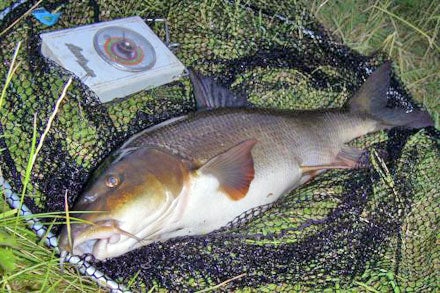  A long, lean 8lb 12oz fish |
Lessons Learned
- Casters are a very visual bait and unless the fish are actively feeding you may not be able to create a feeding frenzy. A few pellets introduce enough smell to encourage the fish to grub about.
- In a mixed group of barbel and chub the wary chub act as sentinels. If you spook the sentinel chub you usually spook all the fish in the swim. Even when fishing deeper water a cautious approach pays dividends.
- It’s easy to underestimate the size of fish in your swim. My 6-pounder turned out to be 8lb 9oz. This makes the other barbel in the swim about 6lb and the chub seriously big!
- When you get fish feeding don’t cast straight away. As the more cautious, bigger fish gain confidence they will often push smaller fish out of the way. This will happen even if you are not able to see the fish. Its often worth just feeding a swim for an hour before fishing it – bait and wait!
- Both fish required very little nursing. During warm weather it is really important to use adequate tackle. I used a soft, through action rod with 12lb Berkley XT main line and a 10lb braid hook link. Bait was a pellet banded onto the hook. This tackle allowed me to play the fish firmly and net it quickly. You don’t need fine lines, it’s a myth!
Second Trip – how I failed to fool a double
My second visit about a week later saw sunny conditions with a blustery north west breeze. I crawled to the ‘Nettle Patch Swim’ and sat to observe what was going on before feeding. This time I’d binned the casters and was relying on a mix of 4mm and 6mm pellets of various types with a few broken boilies mixed in. 8mm halibuts would be my hookbait.
The first change from last time was that the breeze made fish spotting difficult and a pike of about 5lb sat just on the slack side of the streamer weed. It was noticeable that the resident fish wouldn’t visit the silt patch, despite them being slightly bigger than the Pike so I decided to fish the clean gravel about 3 yds further down the swim. A couple of handfuls of pellets and an hour’s ‘rest’ saw my prep done and I was ready to fish!
Before casting I crawled to a position where I could see what was going on in the swim. A drop in the breeze revealed two large ghostly shapes hovering just off the nearside weed. Comparison to the resident ‘reference’ fish indicated that both shapes were likely to reach double figures! Don’t cast, think!
It didn’t look like the fish were feeding so I decided to wait until they left the swim and feed pellets in an attempt to get them feeding. I repeated this cycle for a while until, an hour later, the biggest of the two fish returned to the swim and started to feed. I waited until she again left the swim and cast out. My end rig was subtly changed from last week: the tail was increased to about 3ft and I’d added an Enterprise Tackle Hook Skin (see end rig photo above) to the hook in an attempt to disguise the shape and stop glinting. I also decided to sit a yard or two below my rod so that I could watch what was happening. There were no snags to speak of so a few seconds delay in striking wouldn’t do any harm. The fish soon returned to the baited area and began to peck about, rather like a hen picking up corn. After a couple of minutes she left the swim and I was forced to wait again.
This happened twice more. On each occasion the fish fed just upstream of my hookbait, but on the third visit she started to drop downstream towards my bait. She turned slightly in the current and as she did so the change in water flow lifted my hooklength and it dropped across her pectoral fin. She turned, left the swim and didn’t visit it for the rest of the session.
Lessons Learned
- barbel can be very line-shy and will often spook if they see line entering the swim or brush against it. I rely on a long hooklength and positioning my rod tip close to the water’s surface to combat this. This was why I fished the silty area in the first session. The line would be hidden by weed and the disturbed silt would also help. In this instance I needed to nail the hooklink down along its length and I didn’t.
- I think I fed too much pellet. Instead of having to search for food the fish was able to be selective and pick up pellets over a long time. This increased the chances of the fish spooking before she took my bait.
- Later in the season I believe that fish can spook over a large bed of pellets, at the moment they aren’t too bad, but it is still wise to feed pellet sparingly.
- Always take the time to observe what is going on and form your strategy accordingly. Don’t just blindly follow your original plan.
- Fish often won’t enter a swim if there is a pike present, even if they are slightly bigger than the pike. Pike can’t be spooked by bombarding them with 15mm boilies!
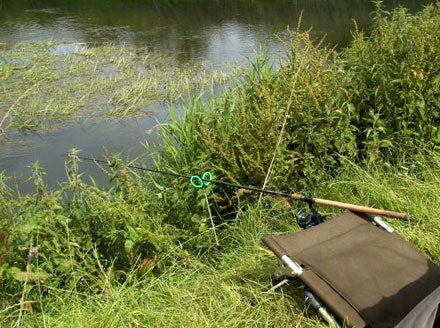  I always keep the rod tip close to the water to prevent fish spooking on seeing or touching the line |
Third Trip – Almost!
Here we are again – can’t fail now! I creep up to the swim and, oh no! A very large pike is sunning herself at the top of the swim. She looks to be in the mid to high 20s and I think no one will mess with her.
I go away and catch a consolation 6-pounder in another swim, but I’m soon drawn back to the nettle patch. I can’t see the pike but the resident barbel and chub are hanging a little further out into the flow on the other side of the streamer weed. This could be because of the pike, but it may well be because the river has dropped and is much shallower and gin clear. I decide to see if I can get them to feed and introduce two small handfuls of mixed pellets just outside the streamer weed. The fish are soon feeding on the pellets, but even after an hour, no bigger fish enter the swim.
Time to cast. I’ve now modified my end rig in an attempt to overcome the problems experienced on the last trip. I’ve covered the hook link swivel with a small amount of tungsten putty and I’ve spaced three SSG shot at 8 inch intervals above this. This gives me approximately 3ft of line nailed down hard to the bottom. I’m using an 8mm halibut pellet banded on to a size 14 hook which, again, has been fitted with a hook skin. A small number of pellets in PVA stocking is hooked over the hook and we’re ready.
The idea is that by now there are very few pellets in the swim and the fish are having to search for them every time they visit it. The PVA bag, placed roughly where they enter the swim, will give them a small pile of freebies which contains my hookbait. The fish leave the swim and I cast.
Ten minutes later the rod hoops round and I’m playing a barbel. At 5lb 12oz it’s one of the resident fish and it is followed by one of the sentinel chub throughout the fight. As I return the fish the chub is sitting on the edge of the fast water. I’m sure she winked at me as she turned away!
A while later I have a barbel of about 9lbs in the swim which is also accompanied by a good chub. I wait until they leave the swim and cast out again. The chub comes back first and finds the pile of pellets. She eats them without taking the hookbait and backs off. The barbel returns, picks about for a while, then moves off upstream, never to return. Oh well!
Lessons Learned
- I think I’ve got the method about right for this swim. The key is to feed sparingly, keep your hooklength well nailed down and give the fish a small pile of freebies where they enter the swim.
- I hate Chub!
- I may never see the big fish here again. You often only get a limited amount of time before the fish move.
So there you go. I hope you’ve found it educational. I’ll let you know if I find the big fish again!
Next week: Part 2 – ‘Moving into the Deeps’













